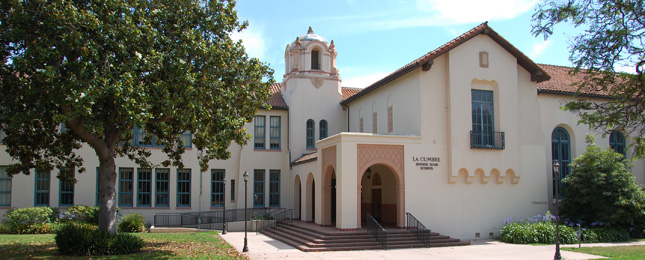
La Cumbre Junior High, courtesy SBUnified.
Touting a closer-knit junior high community, one school aims to turn tide of enrollment
The vibe is different at La Cumbre Junior High these days. While the enrollment numbers are still down, new principal Jo Ann Caines’ dynamic energy seems to be resonating, at least with the people who know the native Santa Barbaran.
Students at Adams School (where she was principal until a few months ago), once a symbol for white flight, are now flocking to La Cumbre.
While only about 450 of the approximately 600 eligible students will attend La Cumbre in the fall, “the composition of our student body is going to be drastically different,” said Caines, “with more of the middle-income and middle- and high-achieving students that didn’t come here before.
“We’ve turned a huge corner thanks to Adams School,” she said, with all but 11 of the more than 100 sixth-graders planning to attend La Cumbre. “So while we’ll be very similar in size, we’ll be hugely different.”
This fall, Caines and assistant principal Jorge Fulco will concentrate on Monroe and Washington schools. Caines has even recruited an Adams fourth-grade parent, Katie Parker, to help her with the outreach.
“Jorge and I have been on the road since Feb. 1 doing outreach,” Caines said. “We gave more tours here … than they have in the prior five years combined.”
Of course, pitching the school is one thing, but telling a compelling story is another — and Caines certainly has one with her reorganization plan.
It might seem to be by design that, when Santa Barbara Community Academy upper-grade students move to La Cumbre’s campus in the fall, the junior high will begin to implement a core knowledge learning community that builds on the same concepts the academy has used successfully. But Caines said she did her research on the core knowledge curriculum (a sequenced, coherent program that uses a grade-by-grade core of common learning) prior to the school board’s decision to move the academy there.
Caines also has a Gifted and Talented Education (GATE)/pre-advanced placement learning community planned, a liberal arts/college preparatory group, and an intensive English development/newcomers community similar to the successful program she implemented at Adams.
Caines emphasized that the communities — which will be separated geographically to make it easier on students — are not tracks.
“Students can participate in any one that they choose or they qualify for,” she said.
Each student will also have a homeroom class where she hopes the smallness of the school will work to its advantage.
“Teachers will not only know their students but the students in that community,” she said.
The staff is coming on board after what Caines characterized as lots of “not easy” discussions.
“Change is hard,” she said. “They’ve been through four principals in two years, so it’s hard to say, ‘Is this really a change or is it going to be different next month kind of thing?’ So what I said to teachers is if it’s not a match for you then you should put in for a transfer because part of what I’m doing is building a new team, and more than anything I want people to be here because they want to be here.”
Three teachers have put in for transfers, but Caines said others are anxious to come to the school because of the new programs.
“Let’s be real. If you asked 100 adults about junior high, 97 of them will say they hated junior high,” she said. “It’s all about friends … Even though we’ll do outreach to the parents, … we’re going to put a lot of energy into the kids, because kids really do decide …They want to go where their friends are.”
Blurred boundaries
Transfers are one of the hot topics of discussion where school needs are concerned. When students transfer in from other districts, the district gets additional money, but intra-district transfers don’t change the funding and campuses like La Colina Junior High (which had only 591 students in 1993-94 and was up to 1,027 students in 2004-05) are getting overcrowded while campuses like La Cumbre Junior High (which had 1,030 students in 1993-94 and now has 433 students) have empty rooms..
Here’s a snapshot look at where secondary students are going (all figures are from the 2004-05 school year):
Junior High
Goleta Valley Junior High School
Incoming: +21 students from other districts; +48 students from within the district (total +69)
Outgoing: -1 student to other districts; -79 students to another school in the district (total -80)
La Colina Junior High School
Incoming: +29 students from other districts; +250 students from within the district (total +279)
Outgoing: -0 students to other districts; -50 students to another school in the district (total –50)
La Cumbre Junior High School
Incoming: +14 students from other districts; +41 students from within the district (total +55)
Outgoing: -2 students to other districts; -257 students to another school in the district (total –259)
Santa Barbara Junior High School
Incoming: +43 students from other districts; +154 students from within the district (total +197)
Outgoing: -2 students to other districts; -107 students to another school in the district (total –109)
High School
Dos Pueblos High School
Incoming: +74 students from other districts; +218 students from within the district (total +292)
Outgoing: -0 students to other districts; -101 students to another school in the district (total –101)
San Marcos High School
Incoming: +61 students from other districts; +325 students from within the district (total +386)
Outgoing: -7 students to other districts; -382 students to another school in the district (total –389)
Santa Barbara High School
Incoming: +151 students from other districts; +268 students from within the district (total +319)
Outgoing: -7 students to other districts; -328 students to another school in the district (total –335)
— Source: PAT SALEY
